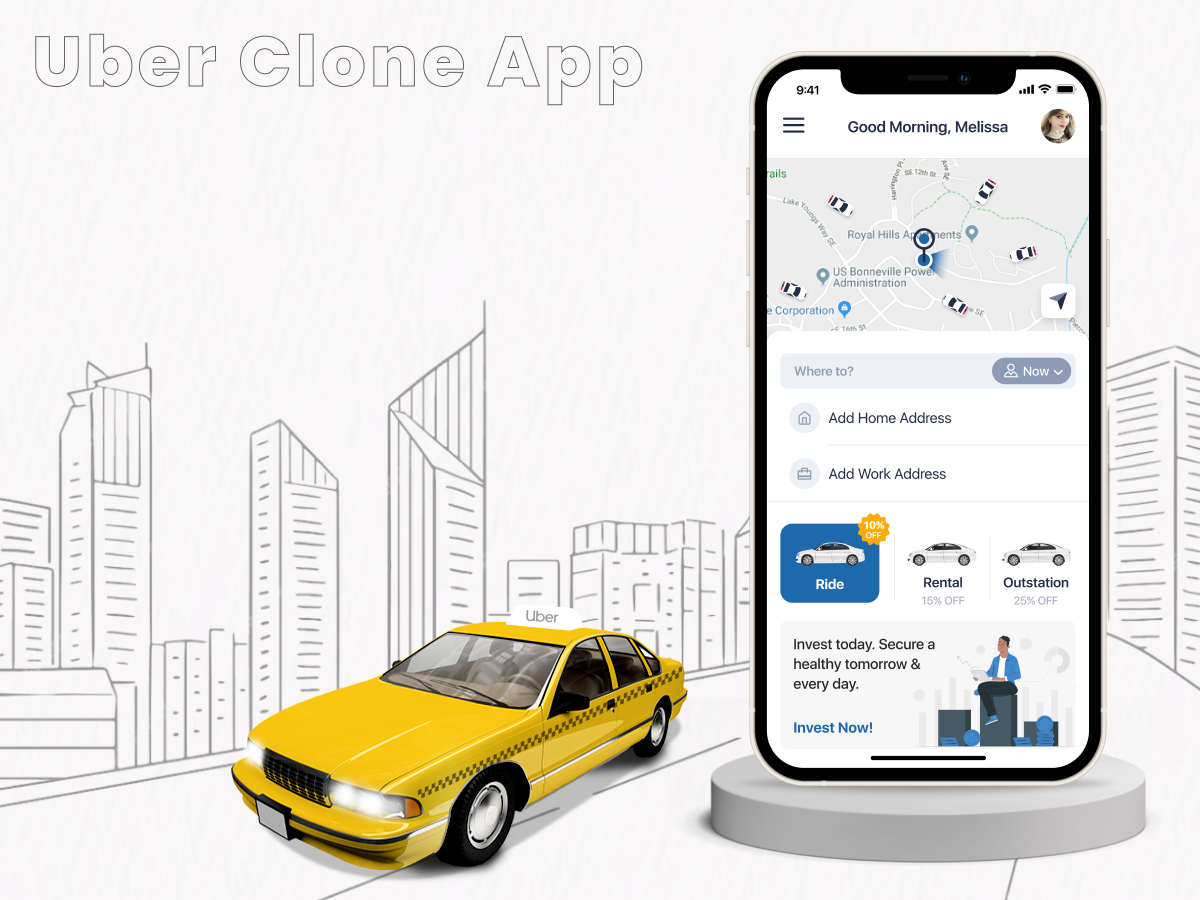Introduction to Uber Clone Apps
The on-demand economy has transformed the way we travel, shop, and access services. At the center of this shift is Uber, which has become the benchmark for ride-hailing success. In 2025, businesses around the world are increasingly turning to Uber Clone Apps, ready-made solutions that replicate Uber’s core functionality while allowing customization for different industries.
What is an Uber Clone App?
An Uber Clone App is a pre-built software solution designed to replicate Uber’s ride-hailing model. It includes three primary components: a user app, a driver app, and an admin dashboard that work seamlessly together. Unlike building an app from scratch, a clone app saves time, reduces cost, and accelerates market entry.
Why are Uber Clone Apps so Popular in 2025?
In 2025, Uber Clone Apps are not just about ride-hailing. They are being adapted for industries such as:
- Food delivery (like Uber Eats)
- Logistics and courier services
- Healthcare transportation
- On-demand home services
Startups prefer them because they provide faster go-to-market timelines, cost-effectiveness, and scalability. Enterprises use them to expand operations and offer Uber-like convenience in their industries.
How Uber Clone Apps Work
For any Uber-like platform, the workflow revolves around seamless coordination between users, drivers, and administrators.
The Three Main Modules – User, Driver, and Admin
- User App: Allows passengers to book rides, track drivers, and make payments.
- Driver App: Let’s drivers accept rides, navigate routes, and manage earnings.
- Admin Panel: Acts as the central hub to manage rides, payments, promotions, and analytics.
Step-by-Step Ride-Booking Process
- A user books a ride through the app.
- The nearest driver gets notified and accepts the request.
- The driver picks up the passenger using real-time GPS navigation.
- Payment is made through integrated gateways.
- Both parties rate and review the experience.
This streamlined process is what makes Uber Clone Apps highly effective and user-friendly.
Key Features of a Successful Uber Clone App
The success of an Uber Clone App lies in its features and functionality.
Must-Have Features for Users
- Simple signup/login (email, phone, or social accounts)
- Live ride tracking with GPS
- Multiple payment options (cards, wallets, digital payments)
- Push notifications for trip updates
- In-app chat and call with drivers
Essential Features for Drivers
- Profile verification and onboarding
- Trip request alerts with route optimization
- Earnings dashboard to track income
- Rating and feedback system
- Work flexibility (go online/offline anytime)
Powerful Features for Admin Panel
- Comprehensive dashboard for real-time monitoring
- Analytics & reports for growth tracking
- User and driver management
- Promo codes and loyalty programs
- Automated payment settlements
These features ensure that all three stakeholders, users, drivers, and admins, enjoy a smooth and reliable experience.
Benefits of Developing an Uber Clone App
Uber Clone Apps are not just cost-effective; they offer strategic advantages for businesses.
Business Scalability
Since clone apps are built on flexible frameworks, they allow easy scaling when user demand grows.
Cost-Efficiency for Startups
Building an app from scratch costs hundreds of thousands of dollars. A clone solution reduces development time and cost by up to 60%.
Ready-to-Launch Solutions
With clone scripts, businesses can launch in weeks instead of months, helping them capture market opportunities quickly.
Technology Stack for Uber Clone App Development
Choosing the right technology stack is one of the most critical steps in building an Uber Clone App. A well-planned tech stack ensures the app’s speed, security, and scalability.
Programming Languages and Frameworks
- Frontend Development: Swift (iOS), Kotlin (Android), React Native or Flutter (cross-platform).
- Backend Development: Node.js, Python (Django/Flask), Ruby on Rails, or Java Spring Boot.
- Frameworks: React.js, Angular, or Vue.js for creating powerful admin dashboards.
By using cross-platform frameworks like Flutter or React Native, businesses save cost and time while reaching both iOS and Android users.
Database and Backend Technologies
- Databases: PostgreSQL, MySQL, MongoDB, and Firebase Realtime Database.
- Backend Storage & Cloud Services: AWS, Microsoft Azure, or Google Cloud for high availability and scalability.
- Caching Systems: Redis or Memcached for faster response times.
The backend must handle real-time data processing (GPS tracking, ride matching, payments), which makes scalable databases and cloud services essential.
Third-Party Integrations (Maps, Payments, Notifications)
- Maps & Navigation: Google Maps API, Mapbox, OpenStreetMap.
- Payment Gateways: Stripe, PayPal, Razorpay, Apple Pay, Google Pay.
- Push Notifications & Messaging: Firebase Cloud Messaging, Twilio, OneSignal.
These integrations are vital for seamless ride tracking, secure payments, and real-time communication between users and drivers.
Cost of Developing an Uber Clone App in 2025
The cost of building an Uber Clone App in 2025 depends on various factors, including location, features, and customization needs.
Factors That Influence Cost
- Features & Complexity: Adding AI, blockchain, or advanced analytics increases costs.
- Platform Choice: Native apps (iOS & Android separately) cost more than cross-platform apps.
- Design Quality: Custom UI/UX design adds to development hours.
- Region of Developers: U.S. developers charge $100–$250/hour, while Indian or Eastern European developers may charge $25–$70/hour.
Average Cost in Different Regions
- USA & Canada: $100,000 – $250,000+
- Western Europe (UK, Germany): $80,000 – $200,000
- Eastern Europe (Poland, Ukraine): $40,000 – $100,000
- India & Southeast Asia: $20,000 – $60,000
Cost-Saving Tips for Startups
- Start with an MVP (Minimum Viable Product) instead of a full-fledged app.
- Use cross-platform frameworks instead of developing native apps.
- Outsource to India or Eastern Europe for high-quality yet cost-effective development.
Uber Clone App Development Process
Building an Uber Clone App involves several stages.
Market Research and Business Planning
Before writing a single line of code, businesses must study target audiences, competitors, and regulations. This helps define unique selling points (USPs) to differentiate from Uber itself.
Designing and Prototyping
A great user experience is key. Prototyping tools like Figma and Sketch are used to design intuitive interfaces for users, drivers, and admins.
Development and Testing
- Frontend & Backend Development: Developers integrate features like GPS, payments, and push notifications.
- Quality Assurance (QA): Testing for bugs, crashes, and scalability.
- Beta Testing: Rolling out to a small user base before the full launch.
Launch and Post-Launch Support
Once live, apps require continuous monitoring, updates, and security patches. Post-launch support is vital to retain users and stay competitive.
Customization Options in Uber Clone Apps
One of the biggest advantages of clone apps is customization.
White-Label Solutions
Businesses can purchase ready-made Uber Clone scripts and rebrand them with their logos, color schemes, and features.
Industry-Specific Modifications
Uber Clone Apps are no longer limited to ride-hailing. They can be adapted for:
- Logistics & Courier Services (parcel delivery, fleet management)
- Food & Grocery Delivery (Uber Eats-style platforms)
- Healthcare Transportation (patient pickup/drop-off services)
Adding Advanced Features like AI and Blockchain
- AI: Smart driver-passenger matching, dynamic pricing, predictive analytics.
- Blockchain: Transparent payments, secure driver verification, decentralized data storage.
These next-gen features make Uber Clone Apps more innovative and future-ready.
Challenges in Uber Clone App Development
While Uber Clone Apps are attractive, businesses must overcome certain challenges.
Technical Complexities
Handling real-time GPS tracking, high-volume transactions, and server scalability can be difficult without expert developers.
Legal and Compliance Issues
Different countries have strict rules regarding ride-hailing businesses, labor laws, and data protection (GDPR, CCPA). Non-compliance may lead to bans or lawsuits.
High Competition in 2025
With Uber, Lyft, Ola, Bolt, and numerous clones already in the market, standing out requires niche targeting (e.g., focusing only on luxury rides, women drivers, or eco-friendly fleets).
Future of Uber Clone Apps
The Uber model is still evolving, and 2025 promises exciting changes.
AI and Machine Learning Integration
AI will enhance fraud detection, predictive demand analysis, and personalized recommendations.
Electric and Autonomous Vehicle Support
Many Uber Clone Apps are preparing for EV fleets and self-driving cars, ensuring eco-friendly and futuristic ride-hailing solutions.
Expanding to New Industries
Beyond transport, Uber Clone Apps are being applied to healthcare, education, logistics, and even beauty services.
Best Uber Clone App Development Companies in 2025
Several companies stand out for their expertise in Uber-like solutions.
Top Companies for Startups
- Code Brew Labs – Known for budget-friendly MVPs.
- Hyperlink InfoSystem – Offers scalable, cost-effective clone solutions.
Top Companies for Enterprises
- Appinventiv – Specializes in enterprise-grade solutions.
- TechAhead – Focuses on high-performance, secure apps.
Offshore Outsourcing Options
- India & Eastern Europe remain the best outsourcing hubs, combining affordability and quality.
Marketing Your Uber Clone App
Building the app is just half the battle; marketing decides its success.
Pre-Launch Marketing Strategies
- Create hype with teaser campaigns and early sign-ups.
- Offer referral bonuses for early users.
Post-Launch Growth Hacks
- Introduce discount codes, loyalty rewards, and surge-free rides.
- Use push notifications and geo-targeted ads to retain users.
Leveraging Partnerships and Local Markets
Partner with local taxi unions, EV providers, and small businesses to grow faster.
Steps to Choose the Right Development Partner
Defining Your App Requirements
Decide your target market, must-have features, and budget before hiring a company.
Questions to Ask Before Hiring
- Have you built Uber-like apps before?
- What technology stack do you use?
- Do you provide ongoing support?
Ensuring Long-Term Support and Scalability
A good development partner offers maintenance, updates, and new feature integration even after launch.
Comparison Table – Ready-Made Uber Clone Solutions vs. Custom Development
Aspect Ready-Made Clone App, Custom Development
Time to Launch 2–4 weeks, 6–12 months
Cost $20k – $50k $100k – $250k+
Scalability Limited initially has High scalability
Customization Moderate (branding, UI) Full control over features
Best For Startups, small businesses, and Enterprises, long-term growth
Conclusion
In 2025, Uber Clone App Development is a game-changing opportunity for startups and enterprises alike. With the right technology stack, features, and development partner, businesses can replicate Uber’s success while targeting unique niches.
The future looks even brighter as AI, EV integration, and industry-specific modifications take Uber-like apps to the next level. Whether you choose a ready-made solution or custom development, the key to success is innovation, compliance, and strategic marketing.
FAQs
How long does it take to build an Uber Clone app?
It typically takes 2–4 weeks for a ready-made solution and 6–12 months for a custom-built app.
Is it legal to create an Uber Clone app?
Yes, as long as you don’t copy Uber’s branding or copyrighted materials. Clone apps must be unique in design and branding.
Can Uber Clone apps be customized for other industries?
Absolutely. They can be adapted for logistics, food delivery, healthcare, home services, and more.
What’s the difference between a clone script and custom development?
A clone script is pre-built and cheaper but has limited customization. Custom development is built from scratch and offers full flexibility, but costs more.
Which is the best country to outsource Uber Clone app development in 2025?
India and Eastern Europe are top choices due to their skilled developers, lower costs, and high-quality results.


